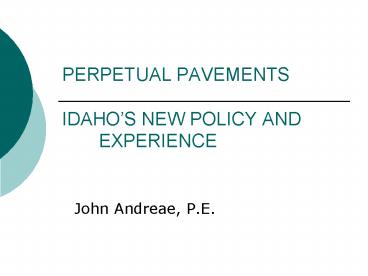PERPETUAL PAVEMENTS IDAHO - PowerPoint PPT Presentation
1 / 30
Title:
PERPETUAL PAVEMENTS IDAHO
Description:
PERPETUAL PAVEMENTS IDAHO S NEW POLICY AND EXPERIENCE John Andreae, P.E. PERPETUAL PAVEMENT What is it? Where did it come from? How do I design it? – PowerPoint PPT presentation
Number of Views:559
Avg rating:3.0/5.0
Title: PERPETUAL PAVEMENTS IDAHO
1
PERPETUAL PAVEMENTSIDAHOS NEW POLICY AND
EXPERIENCE
- John Andreae, P.E.
2
PERPETUAL PAVEMENT
- What is it?
- Where did it come from?
- How do I design it?
- Parameters
- Software
- 1st Project in Idaho
3
WHAT IS IT?
- Bottom up designs
- Build a strong foundation (subbase, base)
- Address limiting strains at specific depths
- Longer Maintenance Intervals
- Manage the rutting potential
- Top with a wear resistant surface
- Mill and inlay on a regular basis
4
(No Transcript)
5
(No Transcript)
6
HISTORY
- Observed success of older pavements
- Common traits were adopted
- Design concept promoted by the Asphalt Pavement
Alliance (2002) - PerRoad software released Jan. 2004
- May 08 Idaho adopted via Materials Memo No. 19
7
(No Transcript)
8
ITD Matls. Operational Memo No. 19
- May 9, 2008 Practical Design Initiative 5
defines as - an asphalt pavement designed built to last 40
yrs. or longer without requiring major structural
rehabilitation or reconstruction, and needing
only periodic surface renewal in response to
distresses at the top of the pavement.
9
MOM 19 HMA BASE LAYER
- Resists fatigue cracking
- Typically SP-5 (10M-30M) or SP-6 (gt30M ESALs)
MOM says SP-1 - Air Voids 2 3
- Target AC content 0.5
- Thickness about 0.25 to 0.35
10
MOM 19 INTERMEDIATE LAYER
- Carries most of the traffic load
- Should be 1 or 1.5 NMA size
- Thickness typically 0.35 to 0.65
11
MOM 19 WEARING SURFACE
- Resists rutting and top down cracking
- Typically will be Stone Matrix Asphalt (SMA)
- Thickness of 0.15 to 0.25
12
PerRoad SOFTWARE
- Developed at Auburn University by Dr. David
Timms in 2002 - Based on layered elastic theory
- Can set design limits for stress/strain
- Top of HMA lt0.02 in. deflection
- Bottom of HMA lt-70 in/in ue (horiz.)
- Subgrade strain lt200 in/in ue (vertical)
13
PerRoad 3.02 Software Input
- Traffic
- Seasonal Data
- Material Properties
- Variability
- Performance Criteria
14
(No Transcript)
15
(No Transcript)
16
(No Transcript)
17
SET PERFORMANCE CRITERIA
18
(No Transcript)
19
IDAHOS 1ST PROJECT
- I-84, GARRITY IC TO TEN MILE RD
- Length 4 miles
- Reconstruct to 6 travel lanes
- No access points between termini
- 2007 AADT 74,000 vehicles per day
- Trucks 9.3 (7300/day)
- Growth Rate 2.6
20
PROJECT TEAM
- ITD HQ Materials
- CIP
- Civil HDR
- Geotech Terracon Consultants
21
IDAHOS 1ST PROJECT
- I-84, GARRITY IC TO TEN MILE RD
- GARVEE funded
- Phase I design was rigid pavement
- Originated from Alternate Bid concept
- Confined by finish grade (already set)
22
IDAHOS 1ST PROJECT
- I-84, GARRITY IC TO TEN MILE RD
- Design period of 40 years
- Life cycle cost analysis performed
- (Salvage value zero _at_ 56 years
maintenance/rehab only) - Superpave HMA Special Provision S405 updated
to address Base (rich bottom) layer
23
PCC PAVEMENT SECTION PCC PAVEMENT SECTION PCC PAVEMENT SECTION PCC PAVEMENT SECTION PCC PAVEMENT SECTION PCC PAVEMENT SECTION PCC PAVEMENT SECTION
11.0" Portland Cement Concrete 11.0" Portland Cement Concrete 11.0" Portland Cement Concrete 11.0" Portland Cement Concrete 11.0" Portland Cement Concrete 11.0" Portland Cement Concrete
0.25 - 0.45' PG Superpave Plant Mix 0.25 - 0.45' PG Superpave Plant Mix 0.25 - 0.45' PG Superpave Plant Mix 0.25 - 0.45' PG Superpave Plant Mix 0.25 - 0.45' PG Superpave Plant Mix 0.25 - 0.45' PG Superpave Plant Mix
12.0" Type B 3/4" Aggregate Base 12.0" Type B 3/4" Aggregate Base 12.0" Type B 3/4" Aggregate Base 12.0" Type B 3/4" Aggregate Base 12.0" Type B 3/4" Aggregate Base 12.0" Type B 3/4" Aggregate Base
12.0" Granular Subbase 12.0" Granular Subbase 12.0" Granular Subbase 12.0" Granular Subbase 12.0" Granular Subbase 12.0" Granular Subbase
Total Total 3.2 3.4 3.2 3.4 3.2 3.4 3.2 3.4 3.2 3.4 3.2 3.4
thickness PG grade depend on traffic control construction staging thickness PG grade depend on traffic control construction staging thickness PG grade depend on traffic control construction staging thickness PG grade depend on traffic control construction staging thickness PG grade depend on traffic control construction staging thickness PG grade depend on traffic control construction staging thickness PG grade depend on traffic control construction staging thickness PG grade depend on traffic control construction staging
24
(No Transcript)
25
(No Transcript)
26
(No Transcript)
27
(No Transcript)
28
PROJECT STATUS
- WB Base Intermediate layers placed in half of
the interior shoulder and lane - WB Intermediate layer partially complete needs
another lift - Test strip for EB Base done this Monday
- Pave EB April/May, switch traffic, finish paving
WB - Complete by October 09 ?
29
IDAHOS 1ST PROJECT LESSONS LEARNED
- Decide early in the project if Alternate Bid is
appropriate! - NEVER second guess the bid outcome!
- 1.5 HMA is easy to segregate
- Advice from others Core before you mill/inlay
(verify crack depth)
30
QUESTIONS ?
- John Andreae, P.E. April 8, 2009
- jlandreae_at_terracon.com































